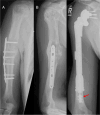Endoprosthetic Reconstruction for Proximal Humerus Tumors
- PMID: 39630212
- PMCID: PMC11732810
- DOI: 10.1007/s12178-024-09933-8
Endoprosthetic Reconstruction for Proximal Humerus Tumors
Abstract
Purpose of the review: Anatomic and reverse endoprosthetic reconstruction are two common surgical options used after tumor resection of the proximal humerus. The purpose of this article is to provide an overview of the functional outcomes and complications of modern anatomic and reverse endoprostheses.
Recent findings: The anatomic endoprosthesis has traditionally been a successful reconstructive technique as it provided a stable platform upon which the hand and elbow could function. However, the reverse endoprosthesis has gradually replaced the anatomic endoprosthesis given that its semi-constrained design affords greater stability. Patients with reverse endoprostheses have improved motion, patient-reported outcome scores, and revision-free implant survivorship compared to those with anatomic endoprostheses. Shoulder function may be further improved with a reverse allograft prosthetic composite (APC) due to reconstruction of the rotator cuff tendons or by transferring the latissimus dorsi and teres major tendons to recreate the function of the posterosuperior rotator cuff muscles. The short-term functional improvement observed with the use of an allograft reconstruction, however, may diminish with longer follow-up due to delayed graft complications, such as resorption, nonunion, and fracture. In most patients undergoing oncologic resection of the proximal humerus, the reverse endoprosthesis or reverse APC is recommended due to improved functional outcomes and reduced postoperative complications compared to other reconstructive techniques.
Keywords: Complications; Endoprosthesis; Megaprosthesis; Outcomes; Proximal humeral tumors; Reverse shoulder arthroplasty.
© 2024. The Author(s), under exclusive licence to Springer Science+Business Media, LLC, part of Springer Nature.
Conflict of interest statement
Declarations. Competing Interests: The authors declare no competing interests.
Figures





References
-
- Lee DH, Hills JM, Jordanov MI, Jaffe KA. Common tumors and tumor-like lesions of the shoulder. J Am Acad Orthop Surg. 2019;27(7):236–45. 10.5435/JAAOS-D-17-00449. - PubMed
-
- Malawer M, Sugarbaker PH. Musculoskeletal Cancer surgery. Springer, Dordrecht; 2001.
-
- Rodl RW, Gosheger G, Gebert C, Lindner N, Ozaki T, Winkelmann W. Reconstruction of the proximal humerus after wide resection of tumours. J Bone Joint Surg Br. 2002;84(7):1004–8. 10.1302/0301-620x.84b7.12989. - PubMed
Publication types
LinkOut - more resources
Full Text Sources
Research Materials

